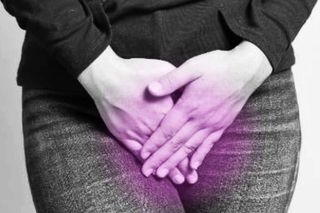
What You Need to Know About Vulvodynia, or Chronic Pain in the Vulva
Up to 16% of women suffer from vulvodynia, a painful condition that can make sitting for long periods or having sex completely unthinkable.

It’s bad enough that women’s pain often isn’t taken seriously by the medical community. But, when they suffer from seemingly innocuous and lesser-known conditions (especially related to genitalia), with unknown or complex causes, such as vulvodynia, the consequences are worse. Not only does the rate of reporting by women fall due to misinformation and taboo, but, in many cases, they are also misdiagnosed by doctors who don’t know any better. According to estimates, between 4% and 16% of all women suffer from vulvodynia, a painful condition that can make sitting for long periods or having vaginal sex completely unthinkable — and even this is likely an underreported figure. So …
What is vulvodynia?
Vulvodynia is a condition characterized by chronic pain, burning, and discomfort in the vulva, for at least three months, that cannot be linked to a specific cause. The vulva is the external part of the female genitalia and prominently includes the pubic mound, the labia majora and minora, the clitoris, the opening of the vagina, and the urethra.
Some women experience the chronic pain associated with vulvodynia in only one area of the vulva, while others experience pain in multiple areas. The pain can go on for months, even years. The constancy (intermittent or constant) and the severity of pain also varies among women who suffer from vulvodynia. The National Vulvodynia Association (NVA) elaborates: “The most commonly reported symptom is burning, but women’s descriptions of the pain vary. One woman reported her pain felt like ‘acid being poured on my skin,’ while another described it as ‘constant knife-like pain.'”
There are two main subtypes of vulvodynia: localized and generalized; the two may, in some cases, exist together.
According to NVA, most women feel pain only in one area of their vulva and are said to be suffering from localized vulvodynia. When that area is in the vestibule, or the tissue around the vaginal opening, the diagnosis is vestibulodynia. The majority of women with localized vulvodynia have provoked vestibulodynia (PVD), in which pain occurs during or after pressure is applied to the vestibule during intercourse, tampon insertion, gynecologic examinations, prolonged sitting, and/or wearing fitted pants. PVD is further categorized into primary or secondary PVD, depending on whether the pain was caused after the very first time pressure was applied to the area (primary) or if the woman experienced pain-free activities development of the pain. A less-common form of localized vulvodynia is clitorodynia in which the clitoris is the location of chronic pain and burning.
For women with generalized vulvodynia, pain occurs spontaneously and is relatively constant in the entire vulval area, with some periods of symptom relief. Activities that directly compress the vulva, such as sitting for long periods of time or vaginal sex, can exacerbate symptoms.
Related on The Swaddle:
Painful Sex Is a Real Medical Condition, But Doctors Often Miss, Dismiss It
What are the symptoms of vulvodynia?
The main symptom is persistent pain in and around the vulva and vagina. What’s important to notice here is that while the vulva might look slightly swollen, more often than not it looks completely normal.
The pain may be a burning, stinging, throbbing, itching, or sore kind of pain; it may be triggered by touch (for instance, during sex or while using a tampon), worsen while sitting down, be localized to rawness at the opening of the vagina, or be spread all over the genital area.
What causes vulvodynia?
Doctors don’t know the exact causes of vulvodynia — yet. Research is currently underway, but the following are a few speculations about what might cause or contribute to it:
- Injury to or irritation of the nerves surrounding the vulval region
- Past vaginal infections
- An abnormal response of vulval cells to environmental factors such as infection or trauma
- Genetic susceptibility to chronic vestibular inflammation, chronic pain, and/or inability to combat infection
- Pelvic floor muscle weakness, spasms or instability
- Allergies or sensitive skin
- Hormonal changes
“Many women with vulvodynia have a history of treatment for recurrent vaginitis or vaginal yeast infections. Some women with the condition have a history of sexual abuse. But most women with vulvodynia have no known causes. Vulvodynia isn’t sexually transmitted or a sign of cancer,” according to Fortis Hospital.
What are the consequences of vulvodynia?
Persistent, unexplained pain in the vulva (and not being able to have vaginal sex) can have a very tangible effect on the mental and emotional health of the woman suffering from it. Vulvodynia can reduce sex drive, alter body image, cause depression and anxiety, lead to disturbed sleep, and cause relationship problems, according to the Mayo Clinic. Fear of having vaginal sex (because it’s so unbelievably painful with vulvodynia) may also lead to vaginismus, or spasms in the muscles around the vagina, when an attempt at sex is made.
Furthermore, pain in the genital area can be embarrassing to discuss and may make the woman feel socially isolated.
How is vulvodynia diagnosed?
The doctor first takes a thorough medical history, followed by an examination of the vulva, vagina and vaginal secretions. At this stage, the doctor may also take routine cultures for infections, and perform blood tests to detect levels of estrogen, progesterone, and testosterone. A cotton-swab test follows, wherein the doctor uses a moistened cotton swab to gently check for specific, localized areas of pain in the vulval region. If during this test anything appears suspicious, the doctor may take a biopsy of the area for further examination.
But essentially, vulvodynia is diagnosed by elimination — that is, once a doctor has eliminated all other possible causes of vulval pain, and the pain cannot be explained.
Fortis Hospital suggests: “If you experience pain in your genital area, discuss it with your doctor, or ask for a referral to a gynecologist. It’s important to have your doctor rule out more easily treatable causes of vulvar pain, such as yeast or bacterial infections, other skin conditions, and medical problems such as diabetes. It’s also important not to repeatedly use over-the-counter treatments for yeast infections without seeing your doctor. Once your doctor has evaluated your particular symptoms, he or she can recommend treatments or ways to help you manage your pain.”
Related on The Swaddle:
What is the treatment for vulvodynia?
Since vulvodynia is not a straightforward condition, doctors prefer a multidisciplinary approach to its management. Because the medical community doesn’t know what causes it, no single treatment works for every woman.
That said, treatments usually focus on managing pain and relieving other symptoms. Current treatment options include:
- Medications: Opioids, tricyclic antidepressants, or anticonvulsants can help lessen chronic pain; antihistamines might reduce itching.
- Biofeedback therapy: This therapy can help reduce pain by gaining greater awareness of the symptoms with the goal of being able to manipulate how the body reacts to them, at will.
- Local anesthetics: Medications, such as lidocaine ointment, can provide temporary symptom relief.
- Nerve blocks: Women who have long-standing pain that doesn’t respond to other treatments may experience relief from local nerve block injections, that are injections of anesthetic on or near a nerve in the painful area.
- Pelvic floor therapy: Exercises to relax tense pelvic floor muscles, which support the uterus, bladder, and bowel, can help relieve vulvodynia pain.
- Surgery: For women with localized vulvodynia or vestibulodynia, surgery to remove the affected skin and tissue (vestibulectomy) is an option.
Regarding antidepressants as a treatment for vulvodynia, Dr. Sherry Ross, OB/GYN, in Santa Monica, California, told Women’s Health: “It’s not clear why antidepressants work for some women with this condition, but they do.” This is also the reason why having vulvodynia is colloquially referred to as having a ‘depressed vagina.’ However, the doses of antidepressants for vulvodynia are much lower than those used for depressive disorders, which means women treating their vulvodynia with an antidepressant prescription can often avoid side effects like weight gain.
Additionally, because vulvodynia can affect a woman’s sex life and emotional well-being, sessions with a psychologist or couples/sex therapist may also be part of the treatment plan.
As far as alternative treatments go, “stress tends to worsen vulvodynia, and having vulvodynia increases stress. Although there’s little evidence that alternative techniques work, some women get some relief from yoga, meditation, massage, and other stress reducers,” according to the Mayo Clinic.
Is there anything else I should know about vulvodynia?
There are some lifestyle changes that can ease the pain of vulvodynia, such as, wearing cotton underwear and loose-fitting bottoms, avoiding scented hygiene products (feminine wipes, soaps, etc.), avoiding plastic pads, applying cool gel packs to the painful area, trying to avoid sex or touching the vulva until the condition is treated, and using support such as a doughnut-shaped cushion while sitting, if it hurts to do so.
Pallavi Prasad is The Swaddle's Features Editor. When she isn't fighting for gender justice and being righteous, you can find her dabbling in street and sports photography, reading philosophy, drowning in green tea, and procrastinating on doing the dishes.
Related


Blue Light Emitted By Gadgets May Kill Brain Cells, Accelerate Aging
